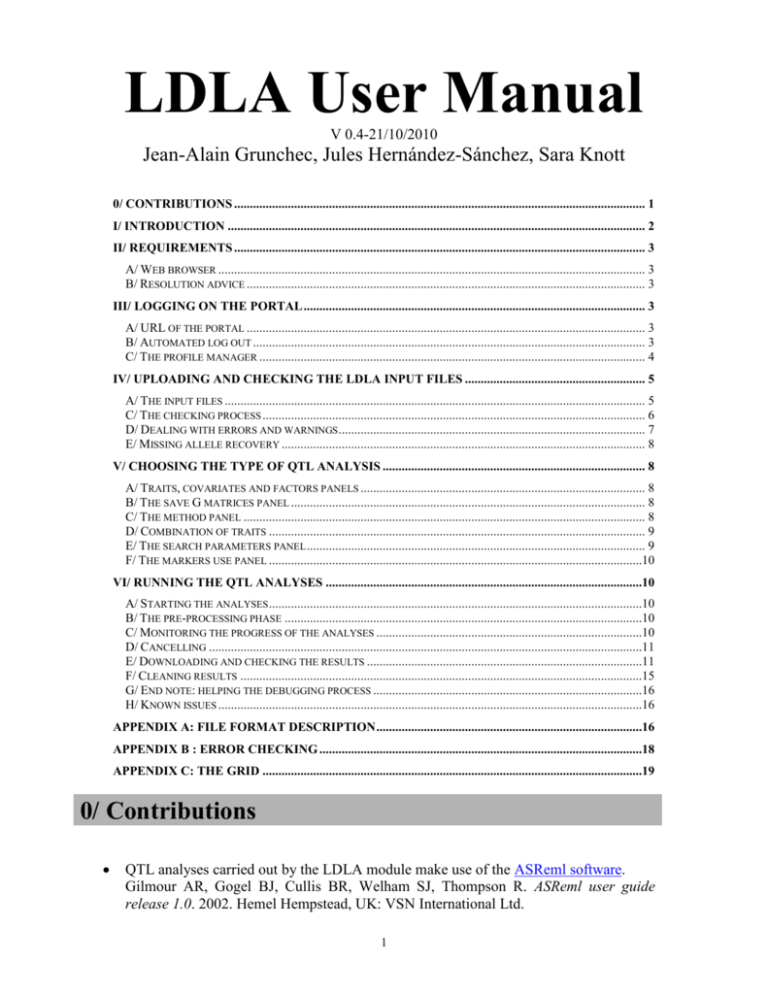
The structures are easier to understand (at least for me) if we express a covariance matrix ( M) as the product of a correlation matrix ( C) pre- and postmultiplied by a diagonal matrix ( D) containing standard deviations Anyway, ASReml supports a large number of covariance structures (and I will present only a few of them), which are particularly useful for longitudinal and spatial analysis.

You will see that the ASReml notation for this type of analysis closely resembles the matrix notation. Similarly, G = A * G 0 where all the matrices are as previously defined and G 0 is the additive covariance matrix for the traits. Matrix for the traits involved in the analysis. I * R 0, where I is an identity matrix of size number of observations, * is the direct product operation (do not confuse with a plain matrix multiplication) and R 0 is the error covariance Other example of a more complex covariance structure is a Multivariate Analysis in one site, where both the residual and additive genetic covariance matrices are constructed as the product of two matrices. For example, an analysis of data from several sites might consider different error variances for each site, that is R = Σd R i, where Σd represents a direct sum (see any matrix algebra book for an explanation) and R i is the residual matrix for site i. However, there are several situations when the analysis require a more complex covariance structure, usually a direct sum or direct product of two or more matrices. For example, the residual covariance matrix in simple examples is R = I σ e 2, or the additive genetic variance matrix is G = A σ a 2 (where A is the numerator relationship matrix). Information, the covariance structure is the product of a scalar (a variance component) by a design matrix. This is because ASReml assumes that, in absence of any additional These steps are somewhat similar to those for the nlme.VC.When fitting simple models (as in many examples of Univariate Analysis) one needs to specify only the model equation (the bit like y ~ mu…) but nothing about the covariances that complete the model specification. It should be noted, however, that the estimates for mod4 do need further formatting in order to obtain the here presented results. This was already achieved via the ods output covparms=modsasVC lines in the PROC MIXED statements in the previous section. Thanks to the ODS (Output Delivery System) in SAS, there are no extra steps required to extract the variance component estimates. We did not use it here, however, since it only seems to provide the sigma estimate and not the varStruct estimates (see github issue). We want to point out that the tidy(effects="ran_pars") function of the broom.mixed package (which we used it in this chapter to obtain the variance component estimates from glmmTMB() models) actually works on lme() objects as well (but it does not on gls() and nlme()). % coef( unconstrained = FALSE, allCoef = TRUE) %>% enframe( name = "grp", value = "varStruct") %>% separate(grp, sep = "", into = c( "grpA", "grpB")) %>% mutate( sigma = me $sigma) %>% mutate( StandardError = sigma * varStruct) %>% mutate( Variance = StandardError ^ 2) , y =, by = "grpB") %>% mutate( sigma = me $sigma) %>% mutate( StandardError = sigma * varStructA * varStructB) %>% mutate( Variance = StandardError ^ 2) % coef( unconstrained = FALSE, allCoef = TRUE) %>% enframe( name = "grpA", value = "varStructA") % coef( unconstrained = FALSE, allCoef = TRUE) %>% enframe( name = "grpB", value = "varStructB") % rename( grpA = Var1, grpB = Var2) %>% left_join( x =.

We achieve this by first creating a unit column in the data with different entries for each data point: By taking both of these actions, we are essentially mimicing the error (variance) as a random effect (variance). Thus, when doing so, we need to make sure to also add a random term to the model with the desired variance structure. We can, however, “ fix the residual variance to be 0 (actually a small non-zero value)” and therefore “ force variance into the random effects” (glmmTMB RefMan) via adding the dispformula = ~ 0 argument. Accordingly, it cannot be used to allow for heterogeneous error variances in this package. Following this trail, the glm documentation description for the weights= argument is “an optional vector of ‘prior weights’ to be used in the fitting process.


In glmmTMB, the RefMan only states “weights, as in glm. In nlme, it requires “an optional varFunc object or one-sided formula describing the within-group heteroscedasticity structure” (nlme RefMan) and we make use of this in the chapter at hand. However, to our understanding, they have different functions: Just like in nlme, there is a weights= argument in glmmTMB(). In glmmTMB() it is -to our knowledge- not possible to adjust the variance structure of the error.


 0 kommentar(er)
0 kommentar(er)
